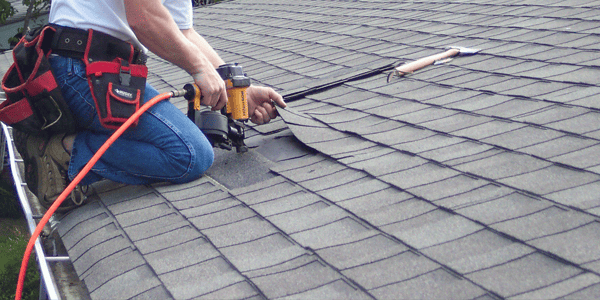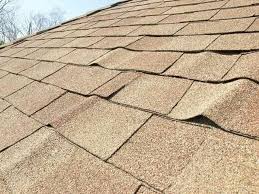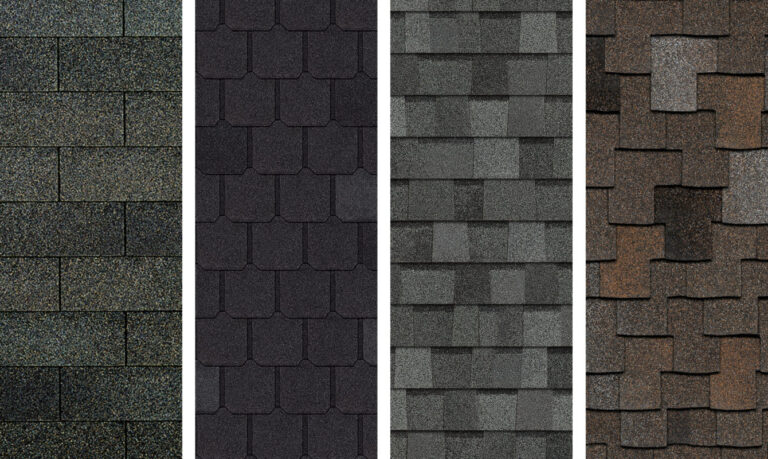Hailstorms can wreak havoc on your roof, leaving you with costly repairs or even a full replacement. But how do you know if your roof has sustained enough damage to warrant such a significant investment? And how much hail damage to replace roof?
In this guide, we’ll explore the intricacies of hail damage, the factors that determine whether a roof needs repair or replacement, and how to navigate the insurance claim process to ensure you receive the coverage you deserve.
From understanding the severity of hail damage to choosing the right roofing contractor for the job, we’ll walk you through every step of the process. Let’s dive in and uncover the secrets to protecting your roof from the costly consequences of hailstorms.
Key Takeaways
- Determining the severity of hail damage is essential to decide whether repair or replacement is necessary.
- Homeowners should review their insurance policy and document roof damage for a successful claim.
- Professional assessment, comparison of quotes from contractors, preventive measures, and consideration of cost vs longevity are key factors in deciding between repairs or full replacement.
Determining the Severity of Hail Damage
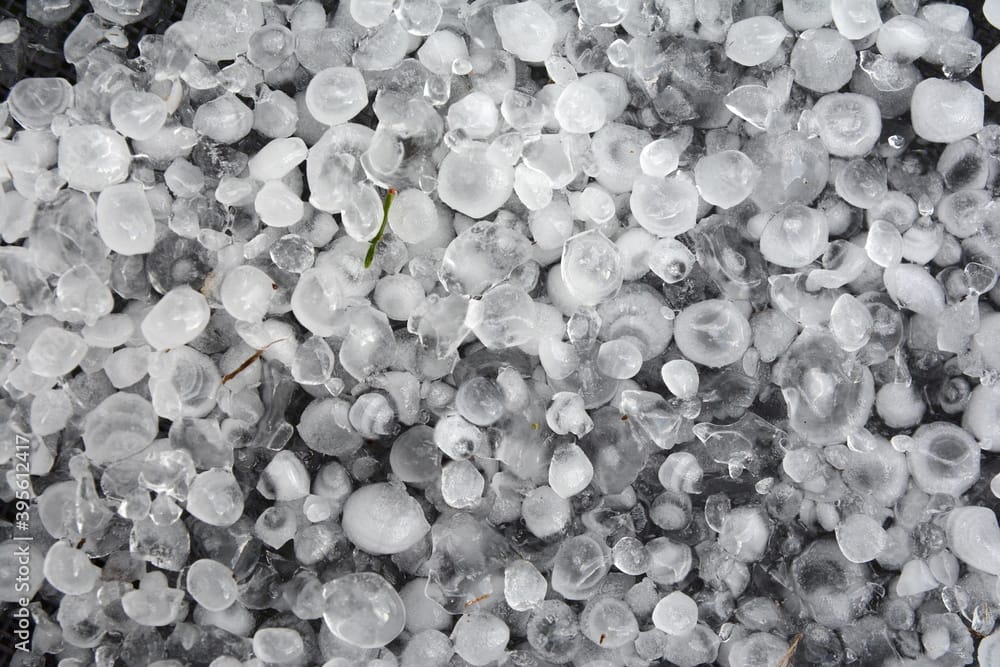
The initial step to tackle hail damage is assessing the severity. This assessment will guide the decision between a simple repair or a complete roof replacement. The extent of the damage depends on several factors, including the types of damage sustained, the roofing materials used, and the age and condition of the roof.
Gaining insight into how much hail damage has occurred, especially roof hail damage, enables homeowners to make informed decisions about roof repair or replacement, potentially leading to significant cost savings.
Later in this blog, we will examine the different types of hail damage, the impact of various roofing materials, and how the age and condition of the roof influence the necessary action steps.
Types of Hail Damage
Hail damage varies greatly, depending on the size of the hailstones and the intensity of the storm. Hailstones with a diameter of 2 inches (5 cm) or more can cause damage to most roofs, while it takes hail that’s 1 inch or larger to damage regular 3-tab organic asphalt shingles.
The scope of damage can range from minor dents and abrasions to significant structural damage caused by the hailstorm. This can lead to roof leaks, water infiltration within the building, and the potential for mold or mildew formation.
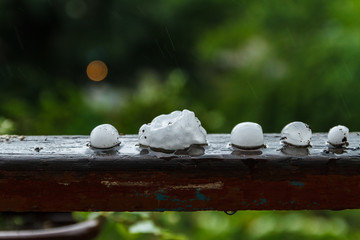
Aside from the size and intensity of the hailstorm, different roofing materials also respond differently to hail impacts. Larger hailstones may be capable of shattering other roofing materials, such as wood shake, concrete, and clay tile roofing, as well as causing damage to metal roofs. As we will delve into later, the selected roofing material significantly influences the repair costs for hail-damaged roofs.
Roofing Materials and Hail Damage
Roofing materials such as asphalt shingles, metal, clay or concrete tiles, and wood shakes each possess varying degrees of susceptibility to hail damage.
For instance, asphalt shingles can suffer dents, cracks, granule loss, and bruising, while metal roofs may experience dents and may even require entire panel replacements in severe cases. The repair costs for these different materials also vary, with metal roof repairs costing between $925 and $1,900 per square and asphalt shingle roof repairs costing between $250 and $600 per square.
The selected roofing material impacts both the type and extent of hail damage and the entire repair costs. Choosing materials with higher resistance to hail damage can potentially reduce repair costs and the necessity for a full roof replacement down the line.
Age and Condition of the Roof
The age and condition of the roof play a significant role in determining whether to repair or replace it after hail damage. An older roof may have deteriorated over time, making it more susceptible to damage and less capable of withstanding the impacts of hail. In such cases, a full roof replacement may be more cost-effective in the long run.
Seeking professional advice from a roofing contractor is key to evaluate the roof’s age and condition and receive expert recommendations for repair or replacement.
Roof Inspection and Insurance Claims
After determining the severity of hail damage, the next step is to have a professional roof inspection and file an insurance claim if necessary. A thorough roof inspection is vital to identify the necessary service for your roof and to document the damage professionally for a claim. Insurance claims are significant to guarantee that all repair expenses are reimbursed.
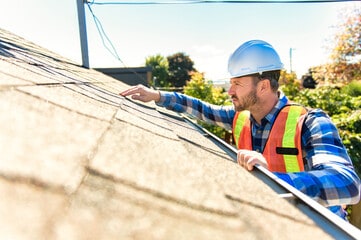
Navigating the insurance claim process can be daunting for many homeowners, especially when dealing with an insurance adjuster and an insurance company. Further in this article, we will cover the significance of professional roof inspection, comprehension of insurance coverage, and advice for successfully filing an insurance claim.
Importance of Professional Roof Inspection
An expert roof inspection is critical to precisely evaluate the extent of hail damage and provide repair or replacement recommendations. While homeowners may be able to spot some signs of hail damage, such as dents or cracks in the shingles, granule loss, or missing shingles, a professional inspector can do much more, including:
- detect more subtle signs of damage that may not be immediately visible
- help homeowners understand the underlying causes of the damage, such as the type and size of hailstones
- provide recommendations for preventive measures to protect the roof in the future
- assist homeowners in filing a successful insurance claim, as their inspection provides documented evidence of the damage
The cost of a professional roof inspection can range from $75 to $600. While it may seem like an additional expense, it can save homeowners thousands of dollars in the long run by ensuring that all necessary repairs are identified and addressed promptly.
Insurance Coverage for Hail Damage
Insurance coverage for hail damage differs from one policy to another, with most homeowner insurance policies typically covering hail damage to the roof. Yet, coverage extent may vary based on the policy details. Homeowners should thoroughly review their policy and discuss with their insurance agent to comprehend the coverage for their unique situation, including the process of filing a hail damage insurance claim.
In addition to understanding their insurance coverage, homeowners should also be proactive in documenting the damage and obtaining multiple quotes for repairs or replacement. This documentation can be crucial in the insurance claim process, as it provides evidence of the damage and the estimated repair or replacement costs. By being proactive and organized, homeowners can increase their chances of receiving the coverage they deserve for their hail-damaged roof.
Tips for Filing a Successful Insurance Claim
When it comes to filing a successful insurance claim for hail damage, there are several tips homeowners should follow. First, document the damage by taking photos or videos of the affected areas, including any visible signs of damage such as dents, cracks, or missing shingles.
Second, obtain multiple quotes from reputable roofing contractors to ensure you receive the best value for your repair or replacement project.
Finally, work with a reputable and experienced roofing contractor who can provide documentation of their work and help you navigate the insurance claim process. By following these tips, homeowners can increase their chances of receiving the coverage they need to address their hail-damaged roof.
Repair vs. Replacement: Factors to Consider

After assessing the severity of hail damage and initiating the insurance claim process, homeowners must decide to repair or replace their roof. This decision hinges on several factors, including damage extent, cost comparison of repairs versus replacement, and the roof’s future protection and lifespan. Carefully considering these factors is vital to make the most suitable decision for your home and budget.
In the subsequent sections, we will delve into these factors in more detail, aiding homeowners in making informed decisions about repairing or replacing their hail-damaged roof.
Extent of Damage
The extent of the damage to your entire roof is a critical factor in determining whether repair or full replacement is necessary. Minor damage, such as a few dents or cracked shingles, can typically be addressed with repairs, while more extensive damage may necessitate a full roof replacement.
Consulting with a professional roofing contractor can provide valuable insight into the extent of the damage and the most appropriate course of action for your particular situation.
Cost of Repairs vs. Replacement
Comparing the cost of repairs vs. replacement is another factor to consider when deciding between the two options. While repairs may be less expensive in the short term, they may not provide the same level of protection as a full roof replacement.
- For example, the cost of repairing hail damage to an asphalt shingle roof is estimated to be approximately $4,250.
- A full roof replacement due to hail damage is reported to be more than $32,500.
This is why it’s essential to weigh the short-term savings of repairs against the long-term benefits of a full roof replacement.
Longevity and Future Protection
Lastly, considering the roof’s longevity and future protection is essential when deciding between repair and replacement. A new roof may provide better protection against future hailstorms and other forms of severe weather, reducing the likelihood of needing repairs or another replacement in the future.
Furthermore, a new roof may offer improved energy efficiency and increased home value, making it a worthwhile investment in the long run. Homeowners should weigh the benefits of a new roof against the costs of repairs and replacement to make the most informed decision possible.
Choosing a Roofing Contractor
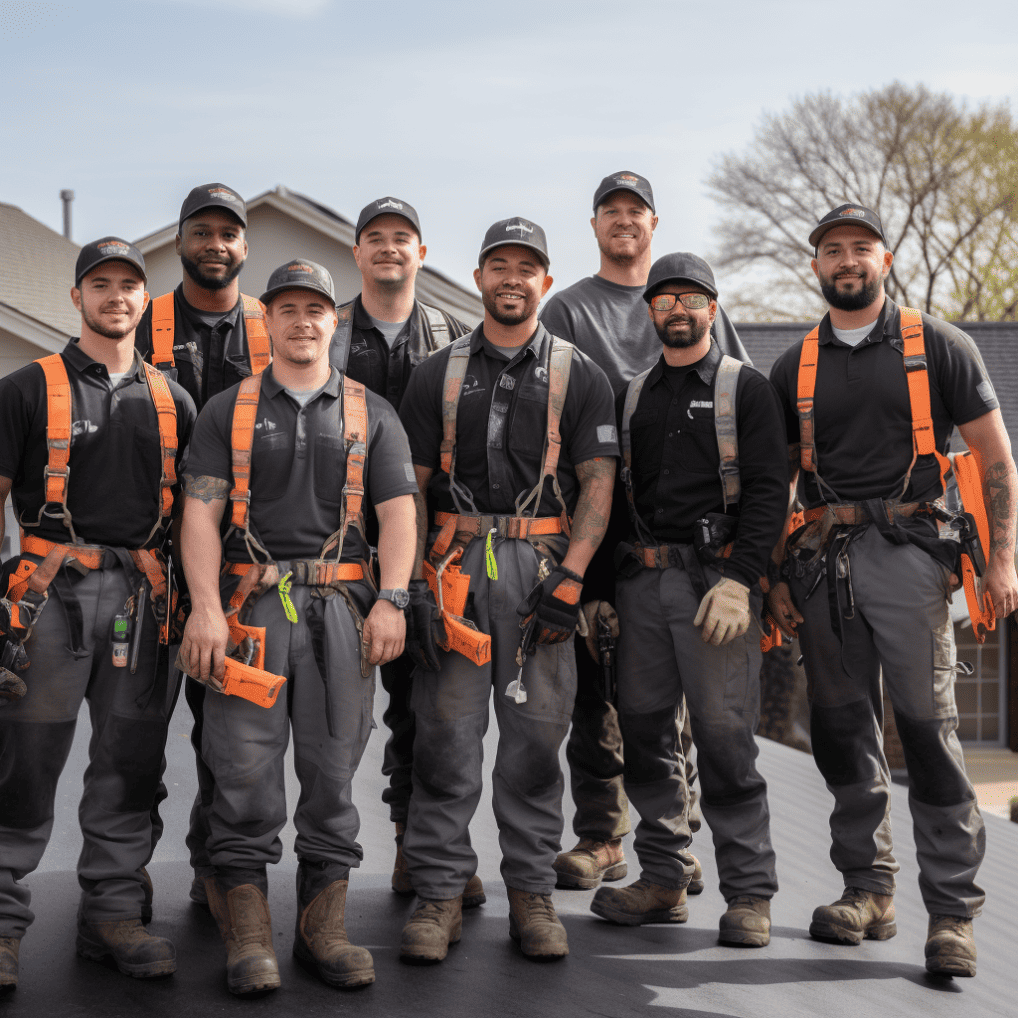
Selecting the right roofing contractor is a crucial step in addressing hail damage to your roof. A reputable and experienced contractor can provide valuable guidance in determining the extent of the damage, navigating the insurance claim process, and performing the necessary repairs or replacement.
How can the right contractor be chosen for your specific needs? Further in this blog, we will consider the factors when selecting a roofing contractor, including their qualifications and experience, customer reviews and references, and the significance of comparing multiple contractor quotes.
Credentials and Experience
When selecting a roofing contractor, it’s important to verify their relevant credentials, licenses, and experience in managing hail damage repairs or replacements. A contractor with a proven track record and a good reputation in the industry is more likely to provide high-quality work and stand behind their services.
Additionally, a contractor with specialized training courses or programs in hail damage repair can offer a higher level of expertise and knowledge in addressing your specific needs.
Customer Reviews and References
Checking customer reviews and asking for references can provide valuable insight into the contractor’s reputation and quality of work. Look for reviews from homeowners who have experienced hail damage to their roofs and have worked with the contractor in question. These reviews can offer a glimpse into the contractor’s work ethic, customer service, and overall satisfaction with the completed project.
Asking for references and speaking with former customers can help you gauge the contractor’s reliability and expertise in handling hail damage repairs or replacements.
Comparing Quotes
Comparing quotes from various contractors can aid homeowners in finding the best value for their hail damage repair or replacement project. When evaluating quotes, consider the quality of materials and services provided, the contractor’s credentials and experience, and the overall cost of the project.
By obtaining quotes from several contractors and carefully evaluating each one, homeowners can ensure they receive the best value and quality work for their hail-damaged roof.
Preventive Measures to Protect Your Roof

Although preventing hailstorms is impossible, homeowners can implement preventive measures to safeguard their roofs against hail damage during a hail storm. By implementing these measures, homeowners can minimize the need for repairs or replacement and save money in the long run.
Alright, now that you now what to do to assess hail damage and follow up with a professional inspection and insurance claim, let’s go over preventive measures. These include:
- regular maintenance
- choosing suitable roofing materials
- installing impact-resistant products
Regular Maintenance
Regular maintenance is a crucial preventive measure that can help minimize hail damage and prolong the life of the roof. By inspecting the roof for any indications of damage, such as missing shingles, cracked tiles, or loose flashing, homeowners can identify and address minor issues before they become more significant problems.
Additionally, regular maintenance, such as cleaning gutters and downspouts and inspecting for any evidence of water damage, can help prevent the need for costly repairs or replacement in the future.
Roofing Material Selection
Choosing roofing materials that are more resistant to hail damage can reduce repair costs and the likelihood of needing a full replacement. Some viable choices for hail protection include:
- Metal roofing: This is the most robust option and can withstand the most intense hail storms.
- Asphalt shingles: These are a popular choice and offer good protection against hail damage.
- Tile roofing: Tiles are durable and can provide adequate protection against hail.
By selecting one of these materials, you can ensure that your roof is better equipped to handle hailstorms and minimize potential damage.
Choosing materials that are more resistant to hail damage, homeowners can potentially minimize repair costs and reduce the likelihood of needing a full roof replacement in the future.
Installing Impact-Resistant Products
Impact-resistant products, such as shingles and underlayment, can provide additional protection against hail damage. These products include impact-resistant shingles, metal roofing, and other materials that have been engineered to absorb the impact of hail.
By investing in impact-resistant products, homeowners can further protect their roofs from hail damage and potentially save money on repair costs in the long run.
Make the Right Choice For Your Roof Replacement
Understanding the severity of hail damage, navigating the insurance claim process, and choosing the right roofing contractor are crucial steps in addressing hail damage to your roof. By following the tips and information provided in this comprehensive guide, homeowners can make informed decisions about whether to repair or replace their hail-damaged roofs and ensure they receive the coverage they deserve from their insurance providers.
Also, preventive measures such as regular maintenance, selecting appropriate roofing materials, and installing impact-resistant products can help protect your roof from future hailstorms.
With proper planning and care, homeowners can minimize the financial impact of hail damage and ensure their roofs continue to provide protection and value for years to come.
Frequently Asked Questions
How much damage does a roof need to be replaced?
If the damage spreads over more than 30 percent of the roof, a new roof installation is necessary to resolve the issue.
What size hail will damage a shingle roof?
Hailstones of at least one inch in diameter can cause damage to a roof and the potential for damage increases with size. Accompanied by strong winds, even smaller hailstones can cause damage, particularly if the roofing materials were not designed to withstand hail impact. Winds can cause the hailstones to move faster and increase the potential for damage. The size of the hailstones and the strength of the winds will determine the amount of damage that can be caused.
Are older roofs more susceptible to hail damage?
Older roofs are more susceptible to hail damage because their granules have been worn down, making them more vulnerable to dents and cracks. Newer roofs, however, are less likely to be affected by hail.
Does insurance cover hail damage?
Yes, most basic home insurance policies and comprehensive car insurance policies will cover hail damage. However, if you live in an area prone to hail storms, you may need additional coverage. Additionally, make sure to keep in mind the ticking clock as claims for hail damage can be expensive and complicated.
What factors determine the severity of hail damage to a roof?
The severity of hail damage to a roof is determined by the types of damage sustained, the roofing materials used, and the age and condition of the roof.
